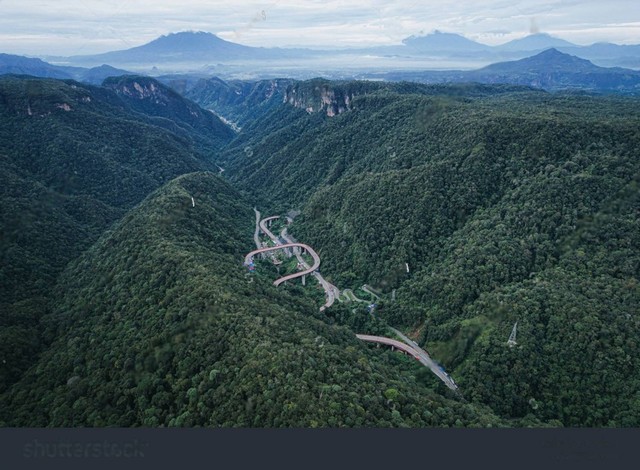Tentang KamiPedoman Media SiberKetentuan & Kebijakan PrivasiPanduan KomunitasPeringkat PenulisCara Menulis di kumparanInformasi Kerja SamaBantuanIklanKarir
2025 © PT Dynamo Media Network
Version 1.101.0
Konten dari Pengguna
Mount Marapi and the Legend of the Origin of the Minangkabau Community
5 Desember 2023 9:34 WIB
Tulisan dari Roma Kyo Kae Saniro tidak mewakili pandangan dari redaksi kumparan

ADVERTISEMENT
In recent times, the community has been stirred by the eruption of Mount Marapi. On the border of Agam Regency and Tanah Datar Regency, West Sumatra, the eruption of Mount Marapi occurred on Sunday, December 3, 2023, around 14:45 WIB. This volcanic event, happening on a specific date and time, unleashed thick smoke, volcanic ash, and pyroclastic materials, creating a significant event that required a swift response from relevant authorities and the responsible volcano monitoring team.
ADVERTISEMENT
Standing at an elevation of 2,891 meters above sea level, Mount Marapi has emerged as one of the most active volcanoes in Sumatra. Historical records dating back to the late 18th century reveal that there have been more than 50 eruptions, encompassing various volcanic activities, including major eruptions and lava flows. The impacts of this volcanic activity extend beyond the local environment and have significant social consequences for neighboring communities.
The eruption of Mount Marapi on December 3, 2023, prompted an increase in the volcano alert level to level 2. As a result, authorities promptly instructed the evacuation of residents within a 3 km radius from the crater center to ensure their safety. The volcano monitoring team actively engaged in monitoring the ongoing developments to provide accurate and timely information to the general public and to support efforts aimed at reducing associated risks.
ADVERTISEMENT
This particular incident serves to underscore the importance of preparedness and awareness in areas vulnerable to volcanic activities. In addition to responding to eruptions efficiently, it is crucial for authorities to continually enhance their efforts in public education regarding volcanic hazards, evacuation protocols, and the implementation of safety measures in the face of potential threats from Mount Marapi.
Mount Marapi, presenting itself as a remarkable geological monument showcasing a rich history of volcanic activities, is renowned not only for its natural attributes but also for its profound connection to mystical narratives and local folktales intricately woven into the daily existence and cultural order of the indigenous community. The eruption of Mount Marapi transcends the realm of mere geological phenomena and goes beyond the natural manifestation of the supernatural, inspiring with spiritual light and delivering messages carefully interpreted by the local residents.
ADVERTISEMENT
With unwavering belief, the local community views the eruption of Mount Marapi as a sign of fortune or communication from the benevolent mountain spirits or entities from another realm believed to inhabit its majestic slopes and summit. This interpretation penetrates the essence of the cultural heritage of the community, forging deep bonds between humanity and nature, the tangible world, and the spiritual realm. The eruption event, therefore, assumes significance beyond the bounds of natural phenomena and is instead considered a profound interaction between humans and mysterious supernatural forces wandering amidst the grandeur of Mount Marapi.
In greater depth, Mount Marapi not only presents the scientific and mystical dimensions but also encapsulates the legend of the origin of the Minangkabau people, the indigenous ethnic group of West Sumatra. In its legendary tales, Mount Marapi is not merely a captivating natural landscape but is also considered the guardian of the legends and myths passed down from one generation to the next, especially among the people of Agam and its surrounding areas.
ADVERTISEMENT
This majestic mountain not only offers a fascinating natural panorama but also holds significant historical value meticulously documented in various "tambo" (oral traditions). Tambo, serving as a complex narrative, intricately details the history of the Minangkabau people, including the lineage of their ancestors. As a narrative medium, tambo not only explains customary regulations but also acts as a cultural foundation for the Minangkabau that remains relevant in the contemporary era.
Through comprehensive records in tambo, the sustainability of the rich heritage and traditions of the Minangkabau community is ensured, and these stories continue to resonate in today's society. Tambo acts as a guardian of collective memory, preserving the roots of culture and history that keep the Minangkabau people connected to their origins. Thus, Mount Marapi is not merely a geological landmark or a source of mystical stories but also a guardian and protector of cultural richness preserved through tambo, an invaluable oral cultural heritage.
ADVERTISEMENT
According to tambo, the narrative of the Minangkabau people's ancestors begins on the grand slopes of Mount Merapi. This intricate explanation becomes evident in Nagari Tuo Pariangan, located in Tanah Datar Regency, recognized as the oldest Nagari in the province of West Sumatra. Nagari Pariangan, functioning as the center of the Nagari-based community governance system in the surrounding area, laid the foundation for the social and political framework that developed within the Minangkabau community.
History validates the belief that the Minangkabau people, according to folklore, can trace their lineage back to the renowned historical figure Alexander the Great, a leader of the Macedonian Empire. In the enchanting narrative of this story, it is stated that Alexander the Great fathered three offspring, one of whom is Sultan Maharaja, who emerged as a significant figure in the formation of the Minangkabau society. After the death of Alexander the Great, the three heirs to the kingdom embarked on a crucial expedition to the designated region.
ADVERTISEMENT
Among the triumvirate of crown princes, it was Sultan Maharaja, ruling as a king alongside his entourage, who eventually arrived at the base of Mount Merapi after sighting a small island, comparable in size to a duck egg. At this juncture, they decided to establish a permanent residence and christened it Nagari Tuo Pariangan. This consequential decision not only resulted in the central settlement but also marked the beginning of the development of the complex social and cultural order of the Minangkabau residents on the undulating slopes of Mount Merapi. This chronicle plays a crucial role in shaping the distinctive identity and rich cultural heritage cherished by the Minangkabau people.
ADVERTISEMENT
Mount Marapi also encompasses many enchanting myths, one of which involves the fascinating tale of a colossal flood that swept through the region of West Sumatra. In this captivating narrative, the stranded entourage of Sultan Maharaja, in a desperate attempt to save their lives amidst the relentless onslaught of a catastrophic disaster, cleverly chose to establish their abode atop the majestic Mount Merapi. Subsequently, when the tumultuous waters finally subsided, a breathtaking sight greeted their eyes: three expansive land basins emerged beneath the towering mountain, eventually baptized as the renowned "luhak nan tigo" or three land basins.
This particular region is carefully delineated into three distinct parts, each playing a special role and offering a myriad of unique characteristics. Nagari Tuo Pariangan, located in Tanah Datar Regency, stands as an ancient noble fortress, submerged in a vast history and adorned with ancient traditions ingrained in the Minangkabau community's structure. On the other hand, Luhak 6 Tengah, encompassing the regions of Agam and Kota Bukittinggi, holds significant influence in shaping the cultural identity of the Minangkabau community, playing a crucial role in preserving their precious customs. Finally, the youngest luhak, embracing Kota Payakumbuh within its embrace, exudes an indelible aura of uniqueness and serves as an invaluable addition to the rich tapestry of cultural diversity and ancient traditions symbolizing the vibrant Minangkabau population.
ADVERTISEMENT
These legends, widely acknowledged as the foundation of Minangkabau society, bestow upon them a tapestry of customs and beautiful cultural practices imbued with a brilliant uniqueness. The extraordinary flood myth and the subsequent division of the region into discreet basins undoubtedly play a pivotal role in sculpting the intricate structure and fostering the social diversity that characterizes the vibrant Minangkabau society. Additionally, it is essential to emphasize the instrumental role played by natural elements like Mount Marapi in the conception and evolution of the Minangkabau people's identity, inspiring with a sense of essence and authenticity that is unquestionable.

